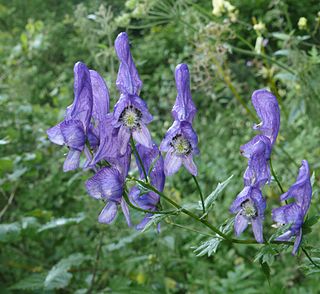
Aconitum, also known as aconite, monkshood, wolfsbane, leopard's bane, devil's helmet, or blue rocket, is a genus of over 250 species of flowering plants belonging to the family Ranunculaceae. These herbaceous perennial plants are chiefly native to the mountainous parts of the Northern Hemisphere in North America, Europe, and Asia, growing in the moisture-retentive but well-draining soils of mountain meadows.

Anemone is a genus of flowering plants in the buttercup family Ranunculaceae. Plants of the genus are commonly called windflowers. They are native to the temperate and subtropical regions of all continents except Australia, New Zealand and Antarctica. The genus is closely related to several other genera including Anemonoides, Anemonastrum, Hepatica, and Pulsatilla. Some botanists include these genera within Anemone.

Ranunculaceae is a family of over 2,000 known species of flowering plants in 43 genera, distributed worldwide.

Platanus × acerifolia, Platanus × hispanica, or hybrid plane, is a tree in the genus Platanus. It is often known by the synonym London plane or London planetree. It is a hybrid of Platanus orientalis and Platanus occidentalis.

Koelreuteria paniculata is a species of flowering plant in the family Sapindaceae, native to China. Naturalized in Korea and Japan since at least the 1200s, it was introduced in Europe in 1747, and to America in 1763, and has become a popular landscape tree worldwide. Common names include goldenrain tree, pride of India, China tree, and the varnish tree.

Commonly known as hellebores, the Eurasian genus Helleborus consists of approximately 20 species of herbaceous or evergreen perennial flowering plants in the family Ranunculaceae, within which it gave its name to the tribe of Helleboreae. Many hellebore species are poisonous.

The JC Raulston Arboretum is a 10-acre (40,000 m2) arboretum and botanical garden administered by North Carolina State University, and located in Raleigh, North Carolina. It is open daily to the public without charge.
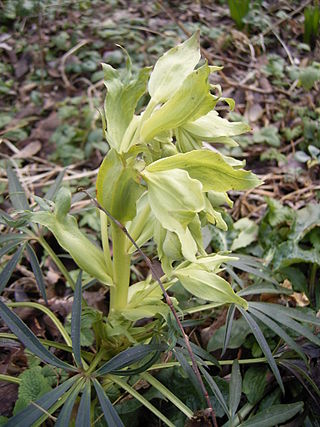
Helleborus foetidus, known variously as stinking hellebore, dungwort, setterwort and bear's foot, is a species of flowering plant in the buttercup family Ranunculaceae, native to the mountainous regions of Central and Southern Europe and Asia Minor. It is found wild in many parts of England, especially on limestone soil.
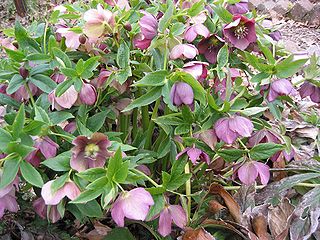
Sunshine Farm and Gardens is an Arboretum, Botanic Garden, garden center, retail and wholesale nursery located at 3,650 feet (1,110 m) altitude near Falling Spring / Renick, Greenbrier County West Virginia. The public is welcome to tour the gardens with prior reservation. Reservations can be made by calling 304-497-2208
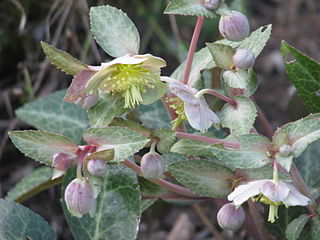
Helleborus lividus is a species of flowering plant in the family Ranunculaceae, native to Majorca and possibly nearby Cabrera, Spain. It is an evergreen perennial growing to 45 cm (18 in) tall by 30 cm (12 in) wide, with deep green or bluish green, glossy leaves and light green or pinkish-green flowers opening nearly flat and appearing from midwinter to early spring. The Latin lividus refers to the colour of the leaves. It may be best grown in a greenhouse in frost-prone areas. Propagation is from seed.

Helleborus cyclophyllus is a flowering perennial plant in the family Ranunculaceae. It is native to Albania, Bulgaria, Greece, and Yugoslavia. It is similar in appearance to other hellebores found in the Balkan region. It is acaulescent, meaning it lacks a stem with leaves, instead sending up a leafless flower stalk. The green leaves are palmate and basal, spreading at the ground. The flowers are green to yellow-green and 2 to 3 inches in diameter.

Epipactis palustris, the marsh helleborine, is a species of orchid native to Europe and Asia.
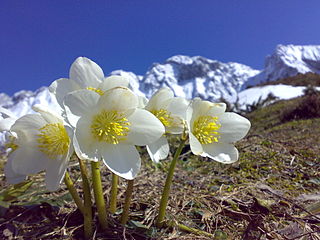
Helleborus niger, commonly called Christmas rose or black hellebore, is an evergreen perennial flowering plant in the buttercup family, Ranunculaceae. It is poisonous.

Aconitum lamarckii, known by the common name Northern wolf's-bane, is a species of herbaceous flowering plant of the genus Aconitum, in the buttercup family, Ranunculaceae. It is native to Europe and sometimes cultivated in gardens in temperate zones for its showy flowers. It blooms from early to late summer with yellow flowers produced on tall, thin, somewhat lax stems.
Brian Frederick Mathew MBE, VMH is a British botanist, born in the village of Limpsfield, Surrey, England. His particular area of expertise is bulbous plants, particularly ornamental bulbous plants, although he has contributed to other fields of taxonomy and horticulture. He has authored or co-authored many books on bulbs and bulbous genera which appeal to both botanists and gardeners, as well as specialist monographs on other genera, including Daphne, Lewisia, and Helleborus. His work has been recognized by the British Royal Horticultural Society and the International Bulb Society.

Helleborus argutifolius, the holly-leaved hellebore, or Corsican hellebore, syn. H. corsicus, H. lividus subsp. corsicus is a species of flowering plant in the family Ranunculaceae, native to Corsica and Sardinia. It is an evergreen perennial growing to 120 cm (47 in) tall by 90 cm (3 ft) wide, with large leathery leaves comprising three spiny-toothed leaflets, and green bowl-shaped flowers in late winter and early spring.

Astrantia maxima,, is a species of flowering plant in the family Apiaceae.

Helleborus viridis, commonly called green hellebore, is a species of flowering plant in the buttercup family Ranunculaceae, native to Central and Western Europe, including southern England. All parts of the plant are poisonous.

Actaea matsumurae, the Kamchatka bugbane or Japanese bugbane, is a species of flowering plant in the buttercup family Ranunculaceae, that is native to Japan, Mongolia and Eastern Russia. Other common names include baneberry, which is also applied to other Actaea species.

Helleborus thibetanus, the Tibetan hellebore, is a species of flowering plant in the family Ranunculaceae, native to China, in S Gansu, NW Hubei, S Shaanxi and NW Sichuan.





















